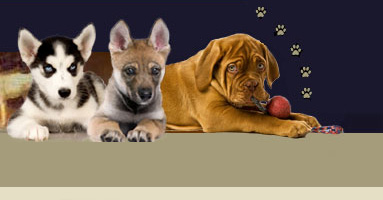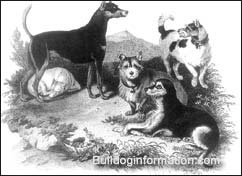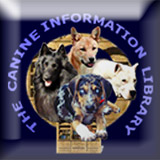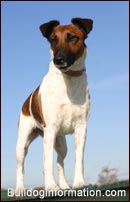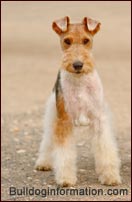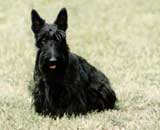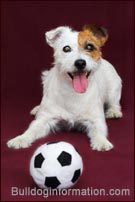Terriers
(Terrier Dog Breeds, Large, Medium-sized, Small and Toy Terrier Breeds)
Terriers are typically small to medium-sized dogs, used for vermin-control and for hunting rats, rabbits, and foxes both over and under the ground. They are usually very active and excitable dogs, showing a proud and tenacious temperament. Many terrier breeds are used to working without human intervention and, as a consequence, need persistent and creative training techniques.
Etymology and Definition
Etymologically the word comes from the French chien terrier, based on the Latin terra firma, 'earth dog', referring to the fact that the terrier pursues its quarry into their burrows.
An exception to this is the Airedale Terrier, which is large in size and used for chasing down otters in and around water.
The term first appears in 1576, written as Terrar or Terrarius, in Johannes Caius' work De Canibus Britannicus (Of English Dogs). The term is used to describe fox and badger hunting dogs that pursue their quarries into the earth. The dogs belonging to this group are described as hunting dogs with an excellent nose.
Not included here in the Terrier group are the bull type terriers (such as the Staffordshire Bull Terrier, Amstaff, Boston Terrier, etc.) which descend from the ancient bull-and-terrier breeds and which were not usually utilized as vermin-controlling earth dogs.
The bull type terriers differ enough in physical appearance and temperament to be considered a separate group. The same goes for the Tibetan Terrier. However, terriers that were created purely as companion dogs, such as the Japanese Terrier, have nevertheless been included here, because their character and conformation remains close enough to the original working terriers.
History
Jack Russel Terrier
Photo: Eric Isselée
In the 19th century, terriers were not yet separated into distinct breeds as they are today.
In Cynographia Britannica (published around 1800), Sydenham Edwards distinguishes two types of terrier: crook-legged and straight-legged.
The ancestors of today's terriers.
(From Sydenham Edwards,
Cynographia Britannica, 1799-1805)
Large Terriers
Airedale Terrier: The Airedale Terrier (short "Airedale") named after the Aire valley, or Airedale, in Yorkshire, England, where it was used to hunt otters along the River Aire. Traditionally known as the "King of Terriers" because it the was the largest of the terrier breeds, until the Black Russian Terrier took that title off him.
The Terrier Handbook
(Barron's Pet Handbooks)
by Kerry Kern (Author)
More information:
Airedale Terrier
Photo by Jane Harvey
Russian Black Terrier: a recent breed of terrier, developed by the Red Star Army Kennels by crossing the Giant Schnauzer, Airedale Terrier, Rottweiler, possibly involving also other breeds. More about the Black Russian Terrier >>
Medium-sized Terriers
Bedlington Terrier: a breed of terrier with a non-shedding, wolly coat, originating from the mining town of Bedlington.
Brasilian Terrier: a game and vermin hunting breed, developed in Brazil from Jack Russell Terriers crossed with miniature Pinschers and possibly also Chihuahuas.

Until 1850, when controlled breeding began, all dogs that went to earth chasing foxes were called fox terriers, indifferently of their county of origin, and each English county had its own fox terrier. In his History of the Dog (1845) W.C.L. Martin recognizes only three types of Terriers: the smooth Terrier, the rough, wire-haired Scotch Terrier, and the long-haired, short-legged Terrier.
These early Terriers were usually black in color with tan markings above the eyes and on the muzzle and legs. Red, fawn and spotted terriers were commonly seen as well. White was the favorite color for hunting terriers, a color that enabled to distinguish them from the prey. Often, their tail was docked and their ears cropped.
Fox Terrier (Smooth): a terrier breed that descends from the now extinct Cheshire and Shrophire Terriers and the Beagle. The Smooth Fox Terrier has a smooth, flat, but hard and dense coat.
Fox Terrier (Wire): similar to the Smooth Fox Terrier, but with a dense, wiry, broken coat.
Canine Information Home >
.
.
.
.
The
Canine Information Library 2003-2009 © All rights reserved by CanineInformationLibrary.com and Caninebreeds.bulldoginformation.com.
Original idea, design and development by C. Marien-de Luca. Photos of upper right corner (from left to right) Husky pup and European wolf cub by Eric Isselée, Bordeaux dog with ball by Paul Cotney. No part of Bulldoginformation.com and Canininformationlibrary.com may be copied, distributed, printed or reproduced on another website without the owner's written permission.
Smooth Fox Terrier
Photo by
Emmanuelle Bonzami
German Hunting Terrier: developed by Bavarian breeders by crossing the Welsh Terrier, the Old English Black-and-Tan Terrier and English Fox terrier, this general-purpose hunting dog can work both above and below ground.
Irish Glen of Imaal Terrier: a terrier breed from Wicklow, Ireland, used for badger-baiting and hunting of fox.
Wire Fox Terrier
Photo by Eduard Titov
Irish Terrier: an excellent water dog and persistent vermin killer, developed in the district around Cork, southern Ireland.
Kerry Blue Terrier: the national dog of Ireland from the County of Kerry, see Kerry Blue Terrier.
Kromfohrländer (Kromfohrlaender): a rare terrier breed, named after the Kromfohr, Germany. It descends from several accidental crosses between a roaming Griffon Vendéen (who had accompanied American soldiers from France to Germany) and a fox terrier bitch owned by Ilse Schleifenbaum who had adopted the dog.
Lakeland Terrier: a working Terrier developed to work the rocky ground of Lake District, England. Originally, the breed was used by farmers in the north of England to protect their livestock from predators.
Manchester Terrier: developed by a breeder from Manchester, called John Hulme, who crossed black-and-tan terriers with Whippets to create an agile and powerful ratter and rabbiter.
Parson Russell Terrier: a strain of wire-haired fox terrier, developed by Reverend John Russell, a founding member of the Kennel Club of Great Britain.
Patterdale Terrier (Black Fell Terrier): a type of Fell Terrier (black-and-tan terrier) used to hunt rats, foxes and rabbits.
Plummer Terrier: developed by crossing Fell-type (lighter-boned and lighter-colored) Terriers with Jack-Russell-type Terriers, adding American Beagle and Bull Terrier blood as well.
Soft Coated Wheaten Terrier: a cousin of both the Kerry Blue Terrier and other Irish Terriers, originating in the counties of Kerry and Cork, southern Ireland.
Welsh Terrier: today more popular in the US than in the UK, this terrier breed of the 1760s was also known as the "Black-and-Tan Wire-haired Terrier" until the 1880s. It gradually replaced a similar, rival dog, the "Old English Terrier", then popular in England. It is one of the most docile and less quarrelsome of all terrier breeds.
Small-sized Terriers
Australian Terrier: the first Australia-bred dog to be shown in Australie, and the first to be recognized overseas.
Border Terrier: a terrier breed originating in the area near the border between Scotland and England, from which it takes its name.
Cairn Terrier: probably the "original" type of Skye Terrier, which is known as Cairn Terrier only since the early 1900s. The breed itself is probably much older.
Cesky Terrier: developed by a Czech geneticist, Dr. Frantisek Horak, who crossed the Sealyham and Scottish Terrier (and possibly also Dandie Dinmont Terriers) to obtain a hunting terrier, similar to the German hunting terrier, but with shorter legs.
Dandie Dinmont Terrier: the only breed to be named after a fictional character (from Sir Walter Scott's novel, Guy Mannering). See also: dog breeds named after a famous person.
Rough-coat Jack Russell
Photo by Antti Karppinen
Scottish Terrier
Photo by Ula Kapala
Jack Russell Terrier: originally bred as a ratter, the Jack Russel Terrier is similar to the Parson Russell Terrier, but with shorter legs and a more varied appearance.
Japanese Terrier (Nihon Teria): a terrier breed descending from small local dogs and Smooth Fox terriers, brought to Japan by the Dutch.
Lucas Terrier: bred by a British breeder, Sir Jocelyn Lucs, from Sealyham bitches and Norfolk Terrier dogs to create a smaller and more efficient working dog.
Norfolk Terrier: similar to the Norwich Terrier, except for the ears.
Norwich Terrier: small, red, bossy terriers, which may be descended from the extinct Trumpington Terrier.
Scottish Terrier: probably a descendant of dogs fromt the Scottish Western Isles.
Sealyham Terrier: a terrier breed developed by Captain Edwards, from the Fox Terrier, Dandie Dinmont and Bull Terrier.
Skye Terrier: a long-haired terrier named after its Scottish island of origin.
West Highland White Terrier: developed from white Cairn Terrier puppies, selectively bred by the Malcolm family of Scotland.
Toy Terriers
AmerToy (American Toy Terrier, Toy Fox Terrier): developed by crossing small Smooth Fox terriers, with English Toy Terriers and Chihuahuas.
Australian Terrier: a native terrier breed of Australia descended from several British terriers (Cairn, Yorkshire, Skye and probably the Norwich) brought to Australia by settlers.
Australian Silky Terrier: probably developed from a cross between the Yorkshire Terrier and the Australian Terrier.
English Toy Terrier: a bonsai version of the Manchester Terrier.
Yorkshire Terrier: long-haired terrier known for its playful demeanor and distinctive blue and tan coat. Read more about the Yorkshire Terrier >>
See also: American Hairless Terrier
Further reading:
- Caius Johannes, Of English Dogs - The Diversities, the names, the natures and the properties.
- Bryan Cummins, The Terriers of Scotland and Ireland. Doral Publishing, 2003.
- Matheson Darley, Terriers of the British Isles, Vintage Dog Books, 2005
- Mentasti G., Stella L., I Terriers, Editoriale Olimpia, 1984
- Jack Russell and his Russel Terriers by Ria Hörter


